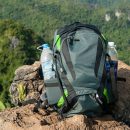Musky Rodent Happenings
Early one December morning while sipping my first coffee, I spotted a small dark shape struggling on our newly nearly frozen lake. After further observations, I discovered it was a muskrat attempting to make his way from the little island in front of my cove to the nearby shore. Every few steps the poor little fellow would sink through the ice and cling to the edge, struggling to make his way back up and out. Once back on his feet, off he would quickly scamper with long tail pointing to the heavens, until again back into the water he would go. This hurry up and sink dance repeated itself countless times until the determined little guy safely made it to shore. Most impressive! So much so, that it inspired me to learn more about our local muskrats, here on Lake Chaubunagungamaug in Webster, Massachusetts.
The muskrat (Ondatra zibethicus) gets its common name from a resemblance to stocky, medium sized rodents, along with their musky odor from scent glands used to mark their territory. Muskrats weigh between 2 to 4 pounds and are typically 18 to 25 inches long with a flat, sparsely haired (scaled) tail that measures between 8 to 11 inches. They are covered with a short, thick brown fur that is doubled layered to help protect them from cold water.
Most of the time the muskrat can be found in the water, swimming underneath up to 17 minutes at a time. They can close off their ears keeping water out, have semi webbed hind feet and a strong tail that propels. When walking on land their tail drags behind them, making it easy to spot their distinctive tracks, especially in the snow.
Muskrats are semi-aquatic, most active at night or near dawn and dusk, with an adaptable lifestyle native to North America. They are most commonly found in wetlands over a wide range of climates and habitats. Specifically, they make their homes throughout still or slow moving waters that include freshwater marshes, beaver ponds, reservoirs, canals and borders of lakes and rivers. The muskrat’s den includes a short tunnel that leads upward from below the water to dry soil. Sometimes there are complex chambers with multiple entrances and even air ducts. They also build lodges in open water around 2 to 4 feet deep, up high enough to keep the den dry.
Food sources for the muskrat include a variety of plants, cattails, bulrush, arrowhead, water lilies, pond weed, clover, ferns and other crops if they are within their territory. When plant varieties are scarce they will also dine on shellfish, snails, fish, salamanders, and frogs. Normally they feed within 150 feet of their primary dwelling when food is abundant, although they will travel much further if necessary. My lake (and yard) offer most of these, making it a perfect location for the muskrat to live and thrive.
Most muskrats make a valuable contribution to aquatic communities. By harvesting plants for not only food, but their dens, they create open water space for ducks, geese, birds and other native wildlife. Other animals and reptiles will periodically share the muskrat’s den or lodge to rest and even nest. Having said that, many of our lake neighbors consider the muskrat a pest, as they have been caught chewing through plastic floating docks, rafts, moorings and even boat ties. They can also damage dams and dikes when over burrowing or eating early sprouting crops, such as my tender young sunflowers near our beach. Muskrats are not climbers, so if we want to protect our beautiful waterfront garden we will need a fence staked at least a foot below ground, as they are determined diggers. One more project for spring!











